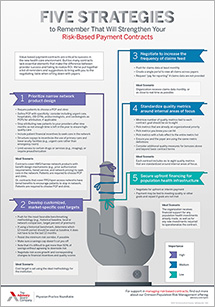Auto logout in seconds.
Continue LogoutHHS officials have signaled support for efforts to transition the U.S. health care system toward value-based payment models, but they are not adhering to payment goals set by former President Barack Obama's administration, according to CMS spokesperson Raymond Thor.
Download our ready-to-use slides on CMMI’s Oncology Care Model
Background
Under the Obama administration, HHS in early 2015 announced a goal of making 30% of Medicare payments for hospitals and physicians through alternative value-based payment models, such as ACOs and bundled payments, by the end of 2016. After achieving that goal in March 2016, HHS said it would aim to tie 50% of Medicare payments to alternative payment models by the end of 2018.
CMS is not tied to Obama admin's goal
However, the Washington Post's "PowerPost" reports that Thor last week suggested the Trump administration might slow the shift toward value-based payments. Instead of aiming for the Obama administration's 50% Medicare payment goal, Thor said CMS plans to review existing value-based programs run by the Center for Medicare and Medicaid Innovation (CMMI) to see whether they are achieving their stated goals.
"The Trump administration's focus has not been on a specific targeted number by the previous administration, but rather on evaluating the impact of new payment models on patients and providers," Thor said.
According to "PowerPost," the shift in focus does not mean the Trump administration is halting efforts to test new value-based payments, it just might do so at a slower pace.
Patrick Conway, who led CMMI before leaving the center last fall, said current HHS officials have expressed their interest in pursuing value-based programs. He said, "It's not like the White House has come out with a new number as a goal, but [CMS Administrator] Seema [Verma] and others—[like HHS Secretary] Alex Azar—have stated their belief that the push for value-based payment needs to continue."
For instance, CMS in September 2017 released an informal proposal outlining potential new payment models and seeking ways to reduce reporting burdens on health care providers. CMS in the proposal said it is interested in using CMMI to increase physician use of alternative payment models, particularly for independent physician practices.
Confusion lingers for industry stakeholders
Health care stakeholders have said it is unclear how CMS will move to address Medicare payments going forward, "PowerPost" reports.
According to "PowerPost," one point of confusion stems from recent leadership changes at HHS.
Former HHS Secretary Tom Price publicly opposed mandatory payment models, and CMS under his leadership proposed—and after Price's resignation finalized—a rule that eliminated three planned mandatory Medicare bundled payment models, scaled back a fourth, and cancelled a cardiac rehabilitation incentive payment model.
However, Azar has signaled a willingness to test mandatory payment models. Azar during a Senate confirmation hearing said, "I believe that we need to be able to test hypotheses, and we have to test a hypothesis, I want to be a reliable partner, I want to be collaborative in doing this, I want to be transparent and follow appropriate procedures, but to test a hypothesis there around changing our health care system, it needs to be mandatory as opposed to be voluntary to get adequate data, then so be it."
Sue Sherry, deputy director for the advocacy group Community Catalyst and a member of HCPLAN, said for there to be progress toward value-based programs, CMS must clearly indicate to doctors, hospitals, and other medical professionals what type of payments they can expect in the future. Sherry said, "You try to run a system with these conflicting incentives, and you have your feet in two different canoes," adding, "Momentum is so important" (Winfield Cunningham, "PowerPost," Washington Post, 2/20).
Medicare 101: Cheat sheets for Parts A through D
Through the years Medicare has grown more complicated, including private supplemental insurance and prescription drug coverage. Download our cheat sheets to learn how each of the four parts of Medicare works, and why they’re so important for provider organizations:
Don't miss out on the latest Advisory Board insights
Create your free account to access 1 resource, including the latest research and webinars.
Want access without creating an account?
You have 1 free members-only resource remaining this month.
1 free members-only resources remaining
1 free members-only resources remaining
You've reached your limit of free insights
Become a member to access all of Advisory Board's resources, events, and experts
Never miss out on the latest innovative health care content tailored to you.
Benefits include:
You've reached your limit of free insights
Become a member to access all of Advisory Board's resources, events, and experts
Never miss out on the latest innovative health care content tailored to you.
Benefits include:
This content is available through your Curated Research partnership with Advisory Board. Click on ‘view this resource’ to read the full piece
Email ask@advisory.com to learn more
Click on ‘Become a Member’ to learn about the benefits of a Full-Access partnership with Advisory Board
Never miss out on the latest innovative health care content tailored to you.
Benefits Include:
This is for members only. Learn more.
Click on ‘Become a Member’ to learn about the benefits of a Full-Access partnership with Advisory Board
Never miss out on the latest innovative health care content tailored to you.

